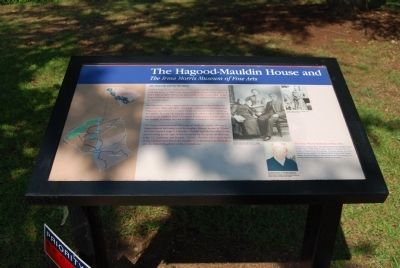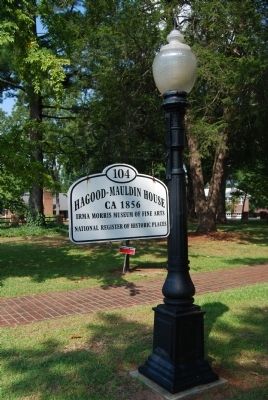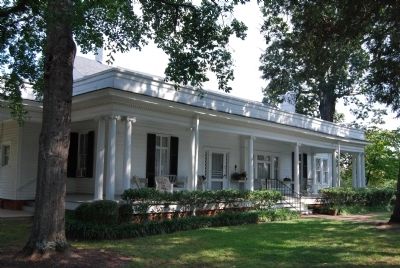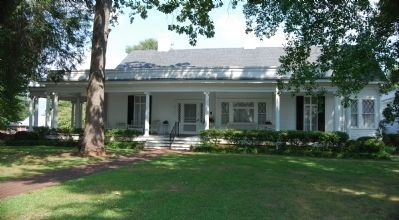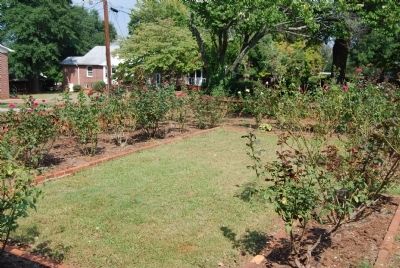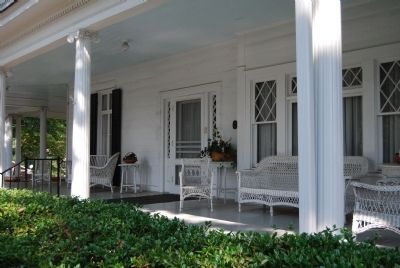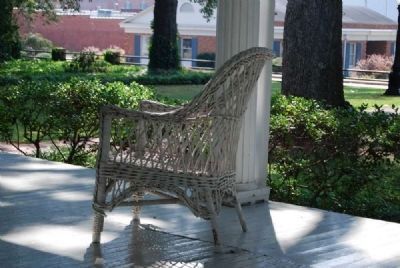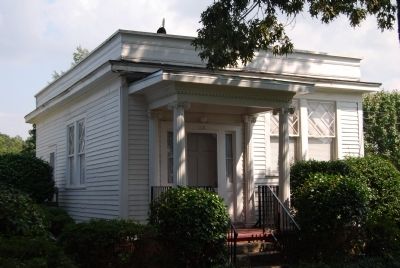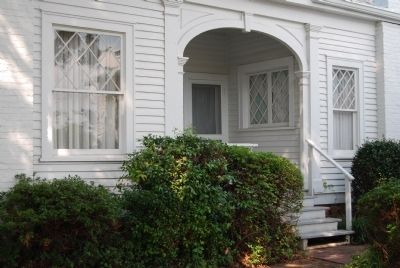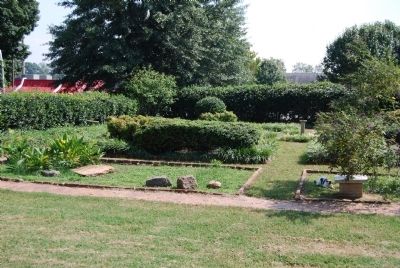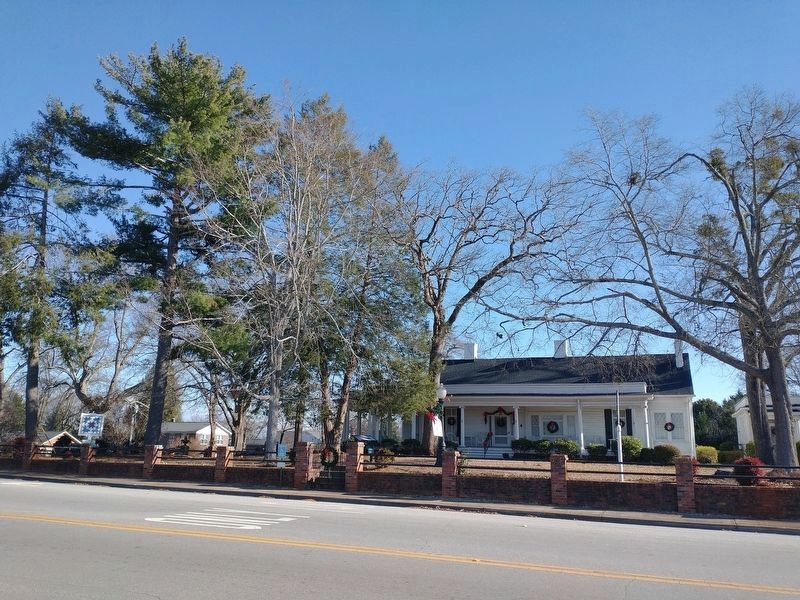Pickens in Pickens County, South Carolina — The American South (South Atlantic)
The Hagood-Mauldin House
The Irma Morris Museum of Fine Art
The Hagoods and the Mauldins
James E. Hagood, son of local farmer and landowner Benjamin Hagood, built this house in 1856 in the town of Pickens Court House, about 14 miles west of here. The house was moved to this site in 1868. James Hagood was among the Commissioners who established the location for the new town.
An Upcountry native, Hagood and his family lived in the house year-round from 1856 until 1873. The family relocated to Charleston after Hagood's appointment as a clerk of the U.S. Circuit Court, a position he held for 30 years. He kept the house and visited it often with his wife and their six children. Many Charleston families had a summer home in the foothills to escape the heat and threat of malaria in the Lowcountry.
The house remained within the Hagood family for nearly 100 years. Hagood passed the house on to his daughter, Francis, known as "Queen." She later married Judge T.J. Mauldin. Mauldin kept his law office in the small building to the right of the house during his career as Attorney, Judge, S.C. Legislator and Senator. "Queen" Mauldin was a social leader of the community, active in the Daughters of the American Revolution and the United Daughters of the Confederacy.
Erected by South Carolina Heritage Corridor.
Topics and series. This historical marker is listed in these topic lists: Arts, Letters, Music • Fraternal or Sororal Organizations • Settlements & Settlers • Women. In addition, it is included in the South Carolina Heritage Corridor, and the United Daughters of the Confederacy series lists. A significant historical year for this entry is 1856.
Location. 34° 53.1′ N, 82° 42.333′ W. Marker is in Pickens, South Carolina, in Pickens County. Marker is on North Lewis Street. Marker is located near the lightpost at the end of the walkway of the Hagood-Mauldin House on North Lewis Street. Touch for map. Marker is at or near this postal address: 104 North Lewis Street, Pickens SC 29671, United States of America. Touch for directions.
Other nearby markers. At least 10 other markers are within walking distance of this marker. A different marker also named Hagood-Mauldin House (a few steps from this marker); Andrew Pickens (within shouting distance of this marker); Pickens (within shouting distance of this marker); Historic Crazy Quilt (within shouting distance of this marker); Carpenter's Wheel (within shouting distance
of this marker); William M. Hagood (within shouting distance of this marker); Garren's Café (about 400 feet away, measured in a direct line); Resting Place (about 500 feet away); Brock's (about 500 feet away); Bivens Hardware (about 500 feet away). Touch for a list and map of all markers in Pickens.
Also see . . . Hagood-Mauldin House. The Hagood-Mauldin House is significant for its architecture and for its association with James Earle Hagood and Judge Thomas J. Mauldin. (Submitted on September 26, 2008, by Brian Scott of Anderson, South Carolina.)
Additional commentary.
1. Hagood-Mauldin House
This one-story frame residence at the corner of North Lewis Street and Queen Court in downtown Pickens, South Carolina, was built for James Early Hagood about 1856 but was constructed in the town of Pickens Court House, often called “Old Pickens,” on the Keowee River some fourteen miles west of its current location. When Pickens District was divided into Oconee County and Pickens County in 1868, the house was disassembled, each board and beam was carefully numbered, and it was loaded into wagons and reconstructed at its present site in the “new” town of Pickens.
It is believed that Mr. Hagood made additions to the house shortly after 1868 and later in 1886. Judge Thomas J. Mauldin expanded the front portico to a Classical Revival style building that he used as his law office. The house itself now includes 4,600 square feet of usable floor space, along with a well-ventilated attic.
The original house was constructed using log beams and joists at floor and attic, each carefully cut, fitted and pegged. Other materials include:
* Exterior siding: slat boards
* Ceilings and walls: flat and beaded plank boards
* Flooring: heart pine planking
* Roofing: cedar wood shingles on open wood slats (two layers of asphalt shingles currently cover the original wood shingles
Each room was heated by a fireplace, and each fireplace mantel and trim has a different design and style. A traditional southern-style deep front porch was located on the west side of the house, with a low sloped roof and round spindle columns to form the entry. The cooking house (kitchen) was to the rear, separated from the main house. Several windows are triple-hung sash with cross lattice glass panels.
The first addition (shortly after 1868) provided a dining room connection to the rear kitchen house with a breezeway separation. Rough-sawn wood framing members at the flour and attic were used. One triple-hung window was relocated to the new dining room. Cedar wood roof shingles appear to have been used to match the original house.
The second addition (1886) provided a side expansion of the front parlor room the rear dining room and created a covered side entry porch. New fireplaces were added to serve the expanded rooms. A bathroom was added to the north side of the house.
The third addition (1904) was by Judge Thomas J. Mauldin. The front porch was expanded to include a covered driveway. The interior living spaces were enhanced with drywall and Victorian trim work. A wood parapet was added to the porch, and fluted Ionic columns provided the present Classical Revival style of the house.
Also in 1904, Judge Mauldin completed the adjacent law office building, which was built to match the style and architecture of the renovated Hagood-Mauldin House.
The general condition of the overall structure of both the residence and the Judge’s office remains good, owing largely to the efforts of volunteers and friends to take decisive steps to restore, renovate and preserve the property from further deterioration. Within the past year, old paint has been removed from the entire house and replaced with fresh paint; repairs have been made to the roof
and exterior structure; the front porch columns have been repaired and repainted; and the electrical system has been upgraded. Further repairs will be carried out in the future with the availability of additional funds to continue with the process.
The Hagood-Mauldin House is currently home to the Irma Morris Museum of Fine Arts and is a popular local tourist attraction.
Judge T.J. Mauldin Office
Constructed in 1904, this one-story frame office contributes to the significance of the nominated property by its association with Judge Thomas J. Mauldin, who married James E. Hagood’s daughter, Francis Hagood (a.k.a. “Miss Queen” Mauldin). The building contains approximately 660 square feet and includes two offices, a kitchen, and a bathroom.
Significance
The Hagood-Mauldin House, which now houses the Irma Morris Museum of Fine Arts, is located at the corner of North Lewis Street and Queen Court in downtown Pickens, South Carolina. The facility is owned and maintained by the Pickens County Historical Society.
The earliest section of the house was built ca. 1856 in Old Pickens Court House. The first owner, James Earle Hagood (1826-1904), son of wealthy landowner Benjamin Hagood, was a public official, lawyer, and planter of Pickens District. Hagood was a merchant until 1856, when he began his public career as Clerk of the Circuit Court of Pickens District, a position he held until 1868. At the outbreak of the Civil War in 1861, Hagood was made Commissioner in Charge of the Poor and a member of the Soldiers’ Board of Relief. He loyally gave material to the cause of the Confederacy. Among his duties, he made several trips to and from the battlefields of Virginia, bringing home the sick and wounded soldiers as well as recovering the bodies of soldiers who had died in service and ministering to the destitute and dependent families of the soldiers in the field.
When Pickens District was divided into Pickens and Oconee Counties in 1868 Hagood was appointed to the Board of Special Commissioners which was authorized to select a site for the town of New Pickens (the present town of Pickens). He acted as Secretary-Treasurer of that Board. He also served as Clerk of the Probate Court in the new county seat and as Clerk of the Board of Pickens County Commissioners (initially convened in 1868). In that year, he had his house dismantled, the rafters and beams numbered, and moved to “new” Pickens; he was soon elected to the South Carolina House of Representatives and served Pickens County in the General Assembly 1869-1872 during the same period that he practiced law with his partner Joseph J. Norton.
In May 1873, Hagood was appointed clerk of the United States Circuit Court for the District of South Carolina in Charleston, serving in that capacity for 30 years. After his death in 1904, his daughter, Francis Miles Hagood, inherited the house, and in the same year married Judge Thomas J. Mauldin. The house was remodeled by the Mauldins from a simple farmhouse with a detached kitchen to a Classical Revival dwelling with a detached law office building in the same style.
Judge Mauldin served as judge of the 13th Judicial Circuit of South Carolina from 1914 until his death in 1931. Mauldin graduated from The Citadel in 1891 and was admitted to the bar in 1892, but he taught for several years before entering the legal profession. He was also editor of a local newspaper for a time, and during his lifetime he was a Mason, a Shriner, a member of the Sons of the Confederacy, and a member of the Sons of the American Revolution. He helped organize, with his wife, the Pickens chapter of the United Daughters of the Confederacy, which held annual meetings on the grounds of the house for many years to honor surviving veterans of the Civil Wars.
Francis Hagood Mauldin remained a social leader of the community active in the Daughters of the American Revolution and was president of the South Carolina Chapter of the Daughters of the Confederacy. It was at her time that the old soldiers of the Confederacy met each June 3 for a parade and a picnic.
In 1954, following the death of Mrs. Mauldin, a nephew, James Morrow Hagood, inherited the house. He sold the property to Mrs. Irma Hendricks Morris, a native of Pickens County with ties to the Oolenoy Valley area. Mrs. Morris, a retired teacher, operated an antiques shop in Beaufort, S.C. In 1968, she moved her business to the Hagood-Mauldin House in Pickens. She continued to collect art and artifacts, and following her death in 1987, the house and furnishings of English and Scottish antiques from the 17th, 18th, and 19th centuries passed by will to the Pickens County Historical Society. The home was opened to the public as a fine arts museum in October 1988. (National Register nomination form.)
— Submitted August 2, 2009, by Brian Scott of Anderson, South Carolina.
2. About Judge Thomas J. Mauldin
Judge Thomas J. Mauldin. There has never been a more popular judge of the Thirteenth Judicial Circuit than the present incumbent, Judge Thomas J. Mauldin of Pickens. This is an assertion vouched for by both the bar and the laity, and Judge Mauldin is fully as popular in the Greenville part of his district as in his home county.
Judge Mauldin is member of a family that has furnished many notable names to the state. He was born in Pickens County in 1870, a son of Joab and Deborah
Reid (Hollingsworth) Mauldin. The Mauldins were influential in the history of the old Pickens District, out of which Pickens County was formed in 1868. His paternal grandfather was Maj. Milton Mauldin, a man of wide prominence in his day, and a major in the old South Carolina Militia before the war. Joab Mauldin served throughout the war between the states in the Confederate army. A cousin of Joab was the late Lieutenant Governor Mauldin of Greenville, whose career with incidental reference to the family history is contained in other pages.
Judge Thomas J. Mauldin was educated in the Military College of South Carolina, The Citadel at Charleston, where he graduated in 1891. He studied law in the office of his uncle the late Col. C. L. Hollingsworth at Pickens. Admitted to the bar in 1892, he began practice with his brother Mr. I.M. Mauldin, now a resident of Columbia. He also taught school for several terms. Judge Mauldin has been a prominent member of the Pickens bar over a quarter of a century. After his brother removed to Columbia he practiced in partnership with Mr. B.A. Morgan, now of Greenville, under the firm name of Morgan & Mauldin. In 1904 he was elected to the Lower House of the Legislature, serving one term, and in 1908 was elected To the State Senate, and at the conclusion of his term in that body entered upon his duties as judge, an office to which he was
elected in 1912.
Judge Mauldin is also director of two banks in Pickens County. He owns three well improved farms in that county. He is a Knight Templar Mason and Shriner and a member of the Methodist Episcopal Church, South. Judge Mauldin married Miss Frances Miles Hagood, a sister of W.M. Hagood of Easley, one of the leading cotton manufacturers of South Carolina. (Source: History of South Carolina by Yates Snowden, pg 30.)
— Submitted August 2, 2009, by Brian Scott of Anderson, South Carolina.
Credits. This page was last revised on January 8, 2024. It was originally submitted on September 26, 2008, by Brian Scott of Anderson, South Carolina. This page has been viewed 2,159 times since then and 73 times this year. Photos: 1, 2, 3, 4, 5, 6. submitted on September 26, 2008, by Brian Scott of Anderson, South Carolina. 7. submitted on August 2, 2009, by Brian Scott of Anderson, South Carolina. 8, 9, 10. submitted on September 26, 2008, by Brian Scott of Anderson, South Carolina. 11. submitted on January 1, 2024, by Tom Bosse of Jefferson City, Tennessee.
